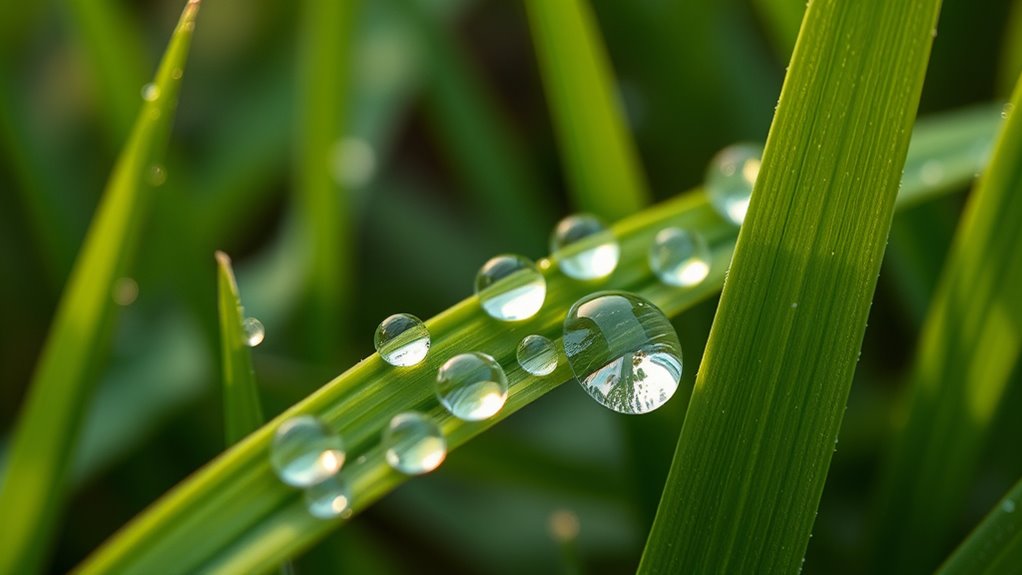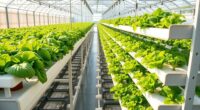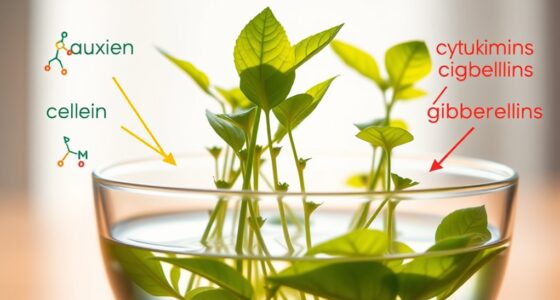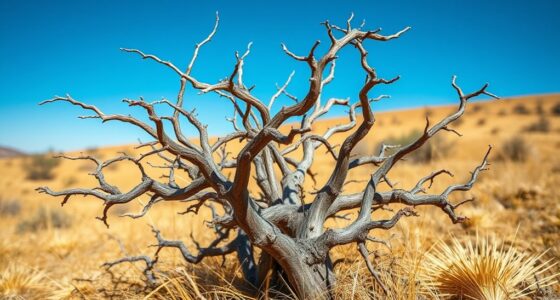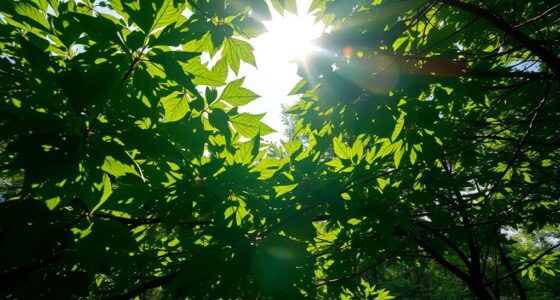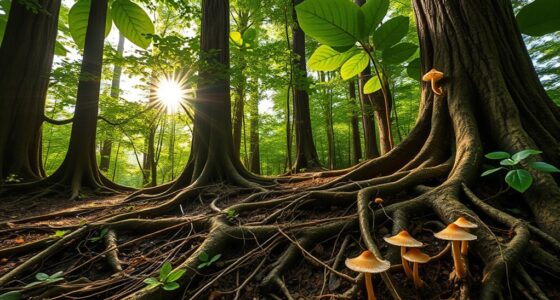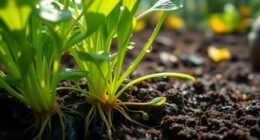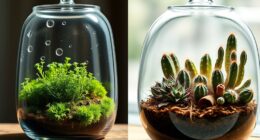Morning droplets on plants might look similar, but they come from different processes. Guttation happens when plants actively push water out through special structures called hydathodes, often at leaf edges, usually overnight. Dew forms passively as moisture from the air condenses on cooler plant surfaces, mainly in the early morning. Understanding these differences can reveal more about your plant’s health and environmental conditions, so keep exploring to learn the details behind these tiny but telling signs.
Key Takeaways
- Guttation droplets are actively expelled by plants through hydathodes, mainly at night, while dew forms passively from atmospheric moisture overnight.
- Guttation indicates internal water regulation and root pressure; dew reflects environmental conditions like humidity and temperature.
- Guttation appears as squeezed-out, often salty-looking droplets at leaf edges, whereas dew settles as uniform water films or beads on surfaces.
- Guttation occurs due to plant processes; dew results from condensation of moisture in the air onto cool plant surfaces.
- Recognizing the droplets helps determine whether plants are actively managing water (guttation) or simply affected by overnight humidity (dew).
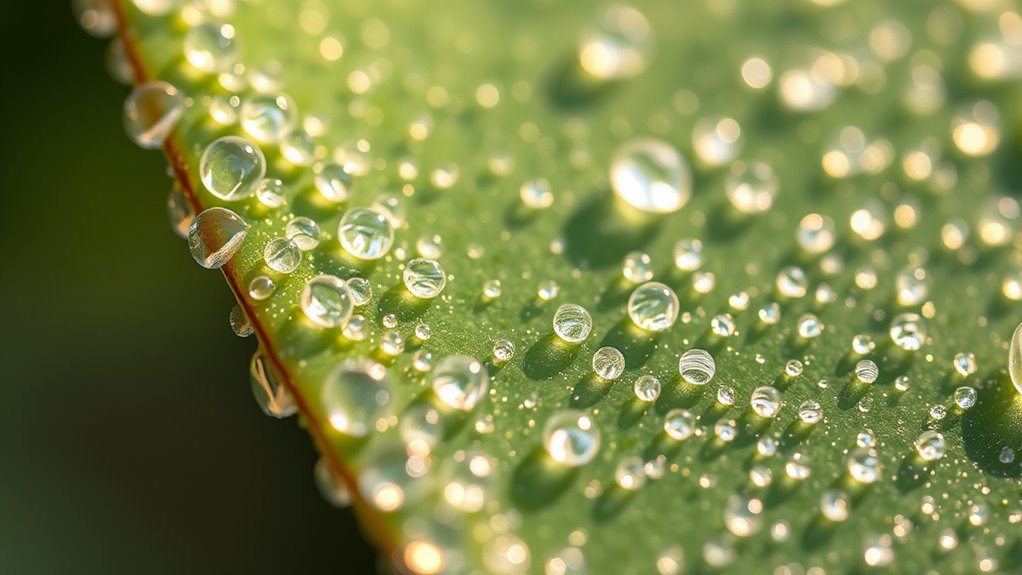
While both guttation and dew involve water droplets on plants, they are distinct processes with different causes. When you notice tiny beads of water on your plants early in the morning, it’s easy to think they’re the same. However, understanding what causes these droplets helps you appreciate the unique ways plants interact with their environment. Guttation occurs when plants actively push water out through specialized structures called hydathodes, typically at the edges or tips of leaves. This process happens mainly during the night when soil moisture levels are high, and transpiration rates are low. As roots absorb water, root pressure builds up, forcing excess water out of the plant. You’ll often see guttation droplets as small, clear beads that appear to be squeezed out rather than evaporated from the air. These droplets contain water, minerals, and sometimes plant sap, and they’re a sign that your plant is healthy and actively managing water intake.
In contrast, dew forms passively from the atmosphere. It happens when the temperature drops overnight, and the air becomes saturated with moisture. As the temperature falls, the air can’t hold all the water vapor anymore, so the excess condenses onto cool surfaces—your plants included. Dew drops are fundamentally tiny clouds of condensed water that settle on the surface of leaves and stems. You don’t see dew droplets because the plant is actively expelling water; instead, it’s simply moisture settling from the air. Dew formation is influenced by environmental factors like humidity, temperature, and surface cooling, rather than the plant’s internal processes. It’s a passive process that relies on atmospheric conditions rather than plant activity. Additionally, high soil moisture levels promote guttation by increasing root pressure, which is vital for understanding how plants manage water. Knowing these differences helps you interpret what’s happening with your plants. If you see water droplets early in the morning that seem to be actively squeezed out, it’s likely guttation. These droplets often appear at the leaf edges or tips and can sometimes have a slightly salty taste due to mineral content. Dew, on the other hand, appears as a uniform coating or small beads on surfaces that have cooled overnight, with no connection to the plant’s internal water regulation. Recognizing whether the droplets are a result of guttation or dew can help you understand your plant’s water status and environmental conditions. Guttation signals active water regulation within the plant, often indicating good hydration, while dew simply reflects the humidity and temperature of the surrounding air. Both are fascinating natural phenomena that show how plants adapt to their environment, but they serve very different roles and are driven by distinct processes.
Frequently Asked Questions
How Can I Tell if Morning Drops Are Dew or Guttation?
To tell if morning drops are dew or guttation, look closely at the plant. Dew forms when moisture condenses from the air, usually on smooth surfaces, and appears as tiny water droplets. Guttation, however, occurs when roots push excess water upward, creating droplets at the edges of leaves or stem tips. Guttation drops often happen overnight and are more concentrated than dew, which forms under humid, cool conditions.
Do All Plants Exhibit Guttation or Dew?
Most plants produce dew or guttation, but not all do equally. You’ll find guttation mostly in plants with high water pressure and roots that push moisture out through specialized structures called hydathodes, usually at night or early morning. Dew forms on almost all plants when the air cools and moisture condenses on surfaces. So, while many plants experience these phenomena, the presence and prominence depend on the plant’s type, environment, and water needs.
Does Guttation Occur During Rainy or Dry Weather?
Guttation typically occurs during dry weather when soil moisture is high, and humidity is low, forcing plants to expel excess water through specialized structures called hydathodes. It’s less common during rainy conditions because high humidity reduces the need for water release. You’ll notice guttation most often in early mornings on specific plants, especially when soil is moist but the air is dry, helping prevent water buildup inside the plant.
Can Guttation Harm Plants or Indicate Health Issues?
Guttation generally doesn’t harm your plants or signal health issues. It’s a natural process where excess root pressure pushes out water droplets, much like a plant’s way of releasing surplus moisture. While excessive guttation might indicate overwatering or root stress, it rarely causes damage itself. You should monitor your plants for other symptoms, but in most cases, guttation is simply part of their normal hydration process.
Are Guttation and Dew Both Visible on Indoor Plants?
Yes, both guttation and dew can be visible on indoor plants, but they appear differently. Guttation manifests as tiny drops of liquid at leaf edges or tips, caused by root pressure. Dew, on the other hand, forms from moisture in the air condensing on cooler surfaces, including plant leaves. You may notice guttation mostly during high humidity or early morning, while dew depends on environmental conditions like temperature and humidity.
Conclusion
So next time you see those shimmering morning drops, remember they’re not just tiny jewels but stories of life’s quiet magic. Guttation and dew each whisper different secrets from nature’s hidden world, like gentle breathings of the Earth’s heart. Embrace these delicate miracles with wonder, knowing they’re fleeting moments of beauty that remind us how vibrant and mysterious the world truly is. Treasure these tiny wonders—they’re nature’s gentle lullabies, waiting to be heard.

